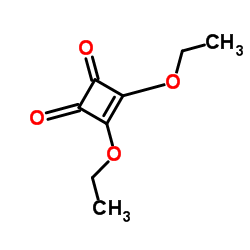Diethyl squarate

Diethyl squarate structure
|
Common Name | Diethyl squarate | ||
|---|---|---|---|---|
| CAS Number | 5231-87-8 | Molecular Weight | 170.163 | |
| Density | 1.2±0.1 g/cm3 | Boiling Point | 325.7±0.0 °C at 760 mmHg | |
| Molecular Formula | C8H10O4 | Melting Point | 19 °C | |
| MSDS | Chinese USA | Flash Point | 135.4±30.7 °C | |
| Symbol |


GHS07, GHS08 |
Signal Word | Danger | |
|
J. Org. Chem. 59 , 4707, (1994)
|
|
|
Organic Synth. 69 , 220, (1990)
|
|
|
J. Chem. Soc. Perkin Trans. I , 263, (1993)
|
|
|
Enzymatic glycosylation of reducing oligosaccharides linked to a solid phase or a lipid via a cleavable squarate linker.
Carbohydr. Res. 319(1-4) , 80-91, (1999) Reducing oligosaccharides were converted into their corresponding glycosylamines, and these were reacted with 3,4-diethoxy-3-cyclobuten-1,2-dione (squaric acid diethyl ester). The resulting derivatives could be linked to amino-functionalized lipids, solids, o... |
|
|
Bioisosteric replacement of the alpha-amino carboxylic acid functionality in 2-amino-5-phosphonopentanoic acid yields unique 3,4-diamino-3-cyclobutene-1,2-dione containing NMDA antagonists.
J. Med. Chem. 35 , 4720, (1992) In this report, a novel bioisostere of the alpha-amino acid, 3,4-diamino-3-cyclobutene-1,2-dione, has been incorporated into a series of compounds which are NMDA antagonists. These compounds, which are achiral and easily prepared, demonstrated good affinity a... |
|
|
Squaric acid mediated synthesis and biological activity of a library of linear and hyperbranched poly(glycerol)-protein conjugates.
Biomacromolecules 13(4) , 1161-71, (2012) Polymer-protein conjugates generated from side chain functional synthetic polymers are attractive because they can be easily further modified with, for example, labeling groups or targeting ligands. The residue specific modification of proteins with side chai... |
|
|
Conjugation of p-aminophenyl glycosides with squaric acid diester to a carrier protein and the use of neoglycoprotein in the histochemical detection of lectins.
Bioconjug. Chem. 2(3) , 148-53, (1991) The coupling of p-aminophenyl 2-acetamido-2-deoxy-3-O-beta-D- galactopyranosyl-beta-D-galactopyranoside (gal-beta 1,3-galNAc) to bovine serum albumin (BSA) was achieved by using 1,2-diethoxycyclobutene-3,4-dione (squaric acid diester) as a new coupling reagen... |
|
|
Squaric acid and esters: analysis for contaminants and stability in solvents.
J. Am. Acad. Dermatol. 13(2 Pt 1) , 229-34, (1985) Two squaric acid diesters, squaric acid diethyl ester (SADEE) and squaric acid dibutyl ester (SADBE), have been suggested as replacements for 2,4-dinitrochlorobenzene in the treatment of alopecia areata and alopecia totalis. We synthesized these squaric acid ... |
|
|
Percutaneous penetration of squaric acid and its esters in hairless mouse and human skin in vitro.
Arch. Dermatol. Res. 280(1) , 57-60, (1988) Squaric acid diethylester and squaric acid dibutylester have been used in contact sensitization therapy of alopecia areata. This study investigated the application of these esters or squaric acid alone to hairless mouse and human skin in vitro to determine sq... |
|
|
Sensitizing potential of cyclobutenediones.
Contact Dermatitis 21(5) , 341-2, (1989)
|